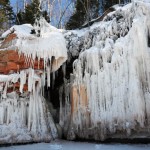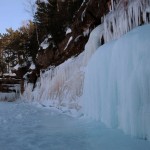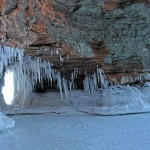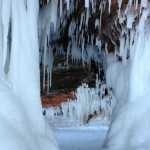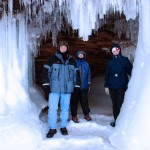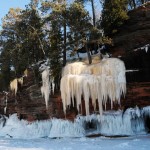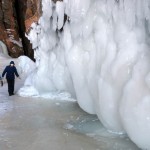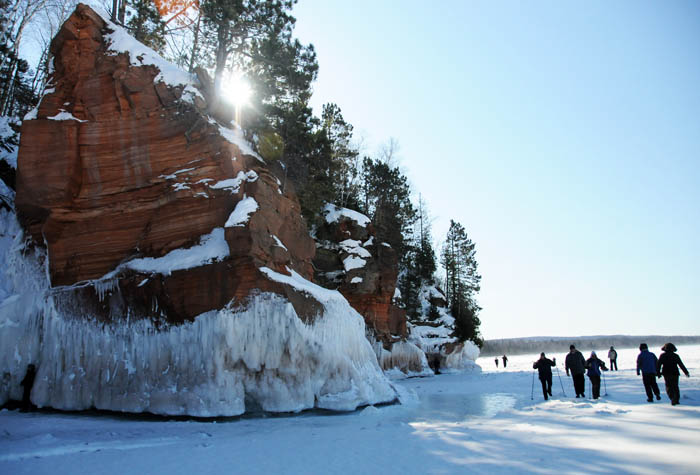
Visitors to Lake Superior’s sea caves head northeast along the Apostle Islands National Lakeshore.
When stepping onto Lake Superior’s ice at Meyers Beach and looking northeast, you realize no one strolls, saunters, or leisurely jogs to the lake’s famous sea caves located more than a mile away.
No, you brace for an endurance march. Mighty Superior’s shoreline is frozen for a simple reason this winter—it’s nose-numbing cold out there! You better dress for Mount Everest if you expect to make the three- to six-mile round-trip hike in comfort. After reaching the caves, you can study nearly two miles of them, so this isn’t your usual walk on the beach.
Do I exaggerate? Not much. Remember, nearby Duluth recently set a record of 23 straight days of below-zero temperatures. Its previous record, 22 days, was set in 1936 and tied in 1963, according to the National Weather Service.
Therefore, unlike the past four winters when milder temperatures never safely froze this portion of the Apostle Islands National Lakeshore, this year’s brutal cold froze not only Superior’s shorelines, but most of the lake itself.
Ice cover on the world’s largest freshwater lake hit 91 percent on February 6, and Great Lakes experts believe ice could still encase the entire lake this winter—if only temporarily—for the first time since 1996. Superior’s annual 40-year average for ice cover in February is 30 percent, and last year it was 38.4 percent.
While Superior’s deepest waters might only have shell-ice, the ice fronting the sea caves and their approach route is nearly 20 inches thick. With ice safe for the first time since 2009, record numbers of people have been trekking to the sea caves.
In Internet terms, the visits have gone viral. The February 7-8 weekend pushed the winter’s crowd estimates past 35,000, inspiring nearby communities to arrange weekend bus-shuttle services from Cornucopia and a parking lot in a field east of town. A third shuttle service runs from the Legendary Waters Casino north of Bayfield on weekends.
The National Park Service, which manages the Apostle Islands National Lakeshore, closed access briefly February 21 when gusts reached 40 mph and heavy snow created hazardous conditions. After the storm blew through, the Service reopened access but advised people to wear snowshoes or cross-country skis until the routes were packed down again.
If you visit on weekdays and arrive before 10 a.m., you’ll probably find a parking space in the Park Service’s visitors’ lot atop Meyers Beach, or along its quarter-mile service road to Highway 13. On weekends, however, visitors often must park two to three miles in both directions along Highway 13.
What’s causing this unprecedented sea-cave pilgrimage? Bob Krumenaker, park superintendent of the Apostle Islands National Lakeshore, lists three factors:
- Conditions that allow sea-cave hikes have become rare. Brutal winters like this haven’t come often the past 25 years, and no one knows when to expect the next one.
- Walking atop Lake Superior is intriguing, if not spooky. This is Gitche Gumme, as Henry Wadsworth Longfellow called it. It’s the lake that never gives up its dead, as the Chippewa noted and Gordon Lightfoot reminds.
- The Internet, email, and social media super charge word-of-mouth advertising. CBS, ABC, NBC, CNN, Reuters, Accu-Weather, Discovery News, Huffington Post, The Weather Channel, Wisconsin Public Radio, and National Public Radio are just some of the news outlets to cover the sea caves this winter, and everyone from Ashland to Barcelona and Sydney to Tokyo is sharing stories via Facebook and Twitter.
Krumenaker said crowds are of magnitudes never before seen at the Apostles Island Lakeshore. In 2013, the Lakeshore attracted 150,000 people the entire year, with only a few thousand visiting in winter.
“When we saw 2,000 people on a Saturday in late January, we thought it was the most crowded we’d ever seen the place, winter or summer,” Krumenaker said. “Then we saw 8,500 the next Saturday and ‘only’ 2,500 when it got colder and windier that Sunday. Our weekend crowds are something you’d expect to see at Yosemite in summer; not in conditions that make you think you’re in Antarctica.”
With all these people flocking to the caves, this wintry story is often more about them than the caves. Some folks walk onto the ice wearing sneakers and ball caps, only to be chased back by sub-zero air and sharp-tongued winds.
Worse, some mopes deliberately damage the ice formations they’ve traveled hundreds of miles to see. For example, a reporter from CBS’s “Inside Edition” is shown in a February 5 broadcast busting off at least three icicles in a frozen sea cave.
She must not have read the Park Service’s warnings on its sea caves website. Still others flick cigarette butts onto the ice, or look away in mock innocence as Rover drops an ice anchor.
The Park Service doesn’t patrol the ice regularly, nor does it post signs or give advice on which sea caves and ice formations to visit. You’re mostly on your own. You decide whether to walk into the caves, through them or past them while inspecting their ice formations.
Visitors can download a map and a seven-page “Frequently Asked Questions” at the Lakeshore’s website. Krumenaker said most visitors are fascinated by the ice formations’ size and varying colors, which are most vivid from mid- to late afternoon when sunlight accents them from the west.
Pink ice is most easily explained, since the water that forms it picks up particles of red granules from the peninsula’s sandstone cliffs. Meanwhile, tiny bubbles of oxygen and other gases trapped in freezing water create white ice formations.
Perhaps the most striking ice formations are tinted blue. This is purer ice with less trapped gases. Without frozen gas bubbles to block and diffuse light, ice absorbs light in the red spectrum, making it less visible to the human eye. This natural filter leaves the blues we see.
Krumenaker said minerals in the frozen water also play a role. There’s a seep behind the most prominent blue ice formation, but no one has identified its minerals.
“All we know is that blue ice forms in the same location every year,” he said with a laugh.
It raises a question for philosophers: If blue ice forms in the same location every year but we can’t walk there to see it, is it really blue?
- A massive ice formation blankets sandstone cliffs along the Apostle Islands National Lakeshore.
- Blue ice formations are thought to be caused by pure, dense ice that filters out colors in the red spectrum.
- Looking west toward Lake Superior from inside a sea cave.
- From left, Tim and Karen Watson, Waunakee; and Penny Durkin, inside a sea cave.
- From left, Tim and Karen Watson, Waunakee; and Penny Durkin, inside a sea cave.
- Ice formations frame sea caves along the Apostle Islands National Lakeshore on Lake Superior.
- Milk-white ice forms when tiny bubbles of oxygen and other gases get trapped in freezing water.
Images by Patrick Durkin
 Your Privacy Choices
Your Privacy Choices
